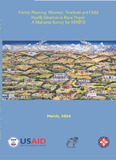Please use this identifier to cite or link to this item:
https://hdl.handle.net/20.500.14356/560Full metadata record
| DC Field | Value | Language |
|---|---|---|
| dc.contributor.author | Nepal Family Health Program II | |
| dc.contributor.author | New ERA | |
| dc.date.accessioned | 2012-12-27T19:39:59Z | |
| dc.date.accessioned | 2022-11-08T10:16:20Z | - |
| dc.date.available | 2012-12-27T19:39:59Z | |
| dc.date.available | 2022-11-08T10:16:20Z | - |
| dc.date.issued | 2010-03 | |
| dc.identifier.uri | http://103.69.126.140:8080/handle/20.500.14356/560 | - |
| dc.description | The Mid-term Survey 2009 for Nepal Family Health Program (NFHP II) was conducted to monitor change in the impact and outcome indicators of NFHP. This included documenting changes in fertility rate, changes in mortality rates for neonates, infants, children and under-five, family planning, maternal health, newborn care practices, child health status, and maternal and child nutrition. Additionally information on knowledge about services provided by Female Community Health Volunteers, maternal incentive scheme and the free health policy were also included. The survey was conducted in 40 districts, which included 20 Core Program Districts of NFHP II and 20 control districts. As the NFHP has focus on the rural areas, all the survey clusters were rural. These clusters were same as that selected for the 2006 Nepal Demographic and Health Survey as the findings from the rural clusters of NDHS 2006 was treated as the baseline for monitoring the changes. The study area spread over 111 rural clusters whereby a total of 3,932 households were enumerated. Overall, 5,019 women age 15-49 were interviewed. | en_US |
| dc.language.iso | en_US | en_US |
| dc.title | Family Planning, Maternal, Newborn and Child Health Situation in Rural Nepal: A Mid-term Survey for NFHP II | en_US |
| dc.type | Technical Report | en_US |
| Appears in Collections: | Post Graduate Grant (PG) Reports | |
Items in DSpace are protected by copyright, with all rights reserved, unless otherwise indicated.

